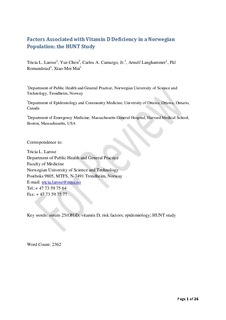| dc.contributor.author | Larose, Tricia L | |
| dc.contributor.author | Chen, Yue | |
| dc.contributor.author | Camargo, Carlos Arthuro | |
| dc.contributor.author | Langhammer, Arnulf | |
| dc.contributor.author | Romundstad, Pål Richard | |
| dc.contributor.author | Mai, Xiao-Mei | |
| dc.date.accessioned | 2017-08-22T11:11:14Z | |
| dc.date.available | 2017-08-22T11:11:14Z | |
| dc.date.created | 2014-04-07T15:34:34Z | |
| dc.date.issued | 2014 | |
| dc.identifier.citation | Journal of Epidemiology and Community Health. 2014, 68 (2), 165-170. | nb_NO |
| dc.identifier.issn | 0143-005X | |
| dc.identifier.uri | http://hdl.handle.net/11250/2451428 | |
| dc.description.abstract | Vitamin D deficiency occurs worldwide. Winter season and high Body Mass Index (BMI) are associated with low levels of serum 25-hydroxyvitamin D (25(OH)D). We estimated the prevalence of vitamin D deficiency in a Norwegian adult population and examined factors associated with vitamin D deficiency. A cohort of 25 616 adults (19–55 years) who participated in both the second and third Nord-Trøndelag Health Study (HUNT 2 (1995–1997) and HUNT 3 (2006–2008)) was established in a previous study. A 10% random sample of the cohort population was recruited for serum 25(OH)D measurements (n=2584), which was used for the current cross-sectional study. Vitamin D deficiency was defined as serum 25(OH)D level <50 nmol/L. The overall prevalence of vitamin D deficiency was 40%, but varied by season (winter: 64%; summer: 20%). Winter season (adjusted prevalence ratio (PR): 3.16, 95% CI 2.42 to 4.12) and obesity (BMI ≥30.0 kg/m2) (PR: 1.74, 95% CI 1.45 to 2.10) were strongly associated with prevalent vitamin D deficiency. Current smoking also demonstrated an increased PR (1.41, 95% CI 1.21 to 1.65). Daily intake of cod liver oil (PR: 0.60, 95% CI 0.41 to 0.77), increased physical activity (PR: 0.80, 95% CI 0.68 to 0.95) and more frequent alcohol consumption (PR: 0.76, 95% CI 0.60 to 0.95) were associated with a reduced PR. The prevalence of vitamin D deficiency was high in Norwegian adults. Winter season, high BMI and current smoking were positively associated, and intake of cod liver oil, increased physical activity and more frequent alcohol consumption were inversely associated with vitamin D deficiency. | nb_NO |
| dc.language.iso | eng | nb_NO |
| dc.publisher | BMJ Publishing Group | nb_NO |
| dc.title | Factors associated with vitamin D deficiency in a Norwegian population: the HUNT Study | nb_NO |
| dc.type | Journal article | nb_NO |
| dc.type | Peer reviewed | nb_NO |
| dc.description.version | acceptedVersion | nb_NO |
| dc.source.pagenumber | 165-170 | nb_NO |
| dc.source.volume | 68 | nb_NO |
| dc.source.journal | Journal of Epidemiology and Community Health | nb_NO |
| dc.source.issue | 2 | nb_NO |
| dc.identifier.doi | 10.1136/jech-2013-202587 | |
| dc.identifier.cristin | 1127505 | |
| dc.relation.project | Norges forskningsråd: 201895 | nb_NO |
| dc.description.localcode | Published by the BMJ Publishing Group Limited. This is the authors' accepted manuscript to the article. | nb_NO |
| cristin.unitcode | 194,65,20,0 | |
| cristin.unitname | Institutt for samfunnsmedisin | |
| cristin.ispublished | true | |
| cristin.fulltext | postprint | |
| cristin.qualitycode | 2 | |
